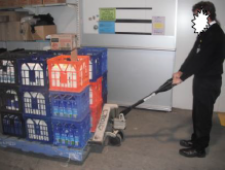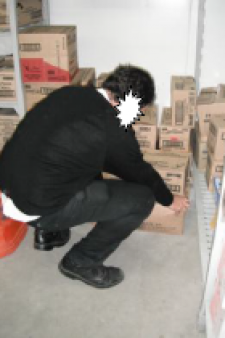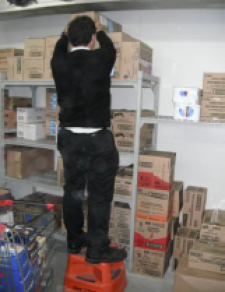Physical demands - grocery store worker - dairy section (stock handling in cool room)
Note
Please note these images are for illustrative purposes only to provide a basic understanding of the tasks involved for this job. They do not necessarily represent compliant or best practice safe work.
Description of photos (below)
- The store size and location determined the number of deliveries of stock per week. For dairy there were multiple pallets of goods delivered by truck and shifted by forklift to the rear of store. taff then used pallet jacks to shift goods to the cool room. The cool room temperature was 1°C.
- Typical weights for milk crates were 16 x 1 litre milk (~17kg), 9 x 2 litre (~ 19kg) and 6 x 3 litre (~19kg). Typical cartons of dairy goods handled in cartons were 6 x 1litre yogurt (6kg), 10 x 1kg custard (10kg) and 12 x 1 kg cheese (12kg). There were bulk items; individual items weighed 250g – 3kg.
- When using the pallet jack, pump forces to elevate the pallet off the ground (photo 1) did not seem to vary greatly for different pallet loads, and was approximately 11kg. The pallet jack handle was gripped as seen in photo 2 with bilateral power grip in pronation with right hand fingers operating the release lever. The handles were at waist height to minimise stooping. Pallet jacks converted push and pull forces to 2- 4% of the weight of the load, eg:
- For typical pallets stacked with typical pallets stacked with 36 crates of milk (<685kg), the inertia-overcoming force to commence or restrain motion was ~20kg depending on rate of acceleration (pace at which the worker pushed or pushed), and in-motion push/pull forces were less.
- For lighter loads, the following forces were required: 450kg pallet load, pump force was 11kg, and 10kg force was required to commence or restrain motion and less to keep in motion. For a 300kg pallet load, pump force was 11kg, and 6kg force was required to commence or restrain motion and less to keep in motion.
- Crates of milk were taken directly to the shop floor for merchandising, or placed in the cool room to be transferred later. Individual milk crates were handled as seen in photo 6 with a power or hook grip in mid supination/pronation, but with varied angles of wrist radial deviation depending on the height of the crate.
- Cartons of dairy goods were stacked on the cool room shelves as seen in photos 3-5. Shelves in the cool room were incremented up to maximum height of 1900mm. For an average-height person this would still require use of a safety step to access the top-most cartons (photo 5), using shoulder flexion <135° for < 12kg loads. For lowest items, bending, squatting or kneeling was required (photo 3). Grip type was usually a hook grip below the carton.
View more physical demand photos for Grocery store worker – dairy section:
More return to work resources
- Download the return to work checklist (PDF, 0.04 MB) for Grocery retail worker
- View the job task analysis for Grocery store worker – dairy section






